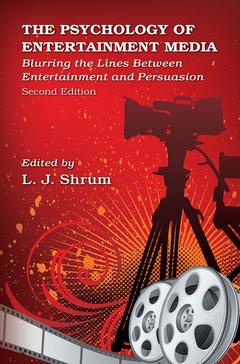The Psychology of Entertainment Media (2nd Ed.) Blurring the Lines Between Entertainment and Persuasion
Coordonnateur : Shrum L. J.

In this volume, psychologists and communication experts present theory on understanding and predicting how learning occurs through media consumption. As the impact of traditional advertising has declined over the last couple of decades, marketers have scrambled to find other ways to effectively communicate with consumers. Among other approaches, marketers have utilized various forms of product integration. Product integration is mixing a commercial message in with the non-commercial message via TV, movie, video, and other entertainment venues. This book will be of interest to students and researchers in psychology, marketing, communication, advertising, and consumer behavior.
L. J. Shrum, What's So Special About Entertainment Media and Why Do We Need a Psychology For It?: An Introduction to The Psychology of Entertainment Media. Part 1. Embedding Promotions within Entertainment Media: Product Placement Effects and How They Work.J. A. McCarty, T. M. Lowrey, Product Integration: Current Practices and New Directions. E. Cowley, As a Backdrop, Part of the Plot, or a Goal in a Game: The Ubiquitous Product Placement. L. Owen, H. Hang, S. Auty, C. Lewis, Children's Processing of Embedded Brand Messages: Product Placement and the Role of Conceptual Fluency. M. R. Nelson, M. K. J. Waiguny, Psychological Processing of In-Game Advertising and Advergaming: Branded Entertainment or Entertainment Persuasion?. Part 2. The Programs between the Ads: The Persuasive Power of Entertainment Media. L. J. Shrum, J. Lee, The Stories TV Tells:How Fictional TV Narratives Shape Normative Perceptions and Personal Values. J. Carpenter, M. C. Green, Flying With Icarus: Narrative Transportation and the Persuasiveness of Entertainment. K. E. Dill, M. C. R. Burgess, Seeing is Believing: Towards a Theory of Media Imagery and Social Learning (MISL). C. A. Russell, D. W. Russell, Alcohol Messages in Television Series: Content and Effects. E. Strahan, V. M. Buote, A. E. Wilson, Selling Beauty: The Hidden Cost to Women's Self-Worth, Relationships, and Behavior. J. A. Maier, D. A. Gentile, Learning Aggression through the Media: Comparing Psychological and Communication Approaches. G. Comstock, J. Powers, Paths from Television Violence to Aggression: Reinterpreting the Evidence.
Date de parution : 05-2017
15.2x22.9 cm
Date de parution : 04-2012
Ouvrage de 354 p.
15.2x22.9 cm
Thèmes de The Psychology of Entertainment Media :
Mots-clés :
product; placements; persuasion; knowledge; alcohol; messages; narrative; transportation; general; learning; Va Ri; Ambivalent Sexism Theory; In-game Advertising; Ingame Advertising; Activate Persuasion Knowledge; Product Placement Effects; Antisocial Behavior; Persuasion Knowledge; General Learning Model; Commercial Messages; Transportation Imagery Model; Hegemonic Masculinity Theory; Alcohol Messages; Restrained Eating; Violent Portrayals; Van Reijmersdal; Benevolent Sexism; Young Man; Product Placement; Perceptual Fluency; Narrative Transportation; Violent Erotica; Interpersonal Rejection; Promotional Consideration; Brand Inclusion



